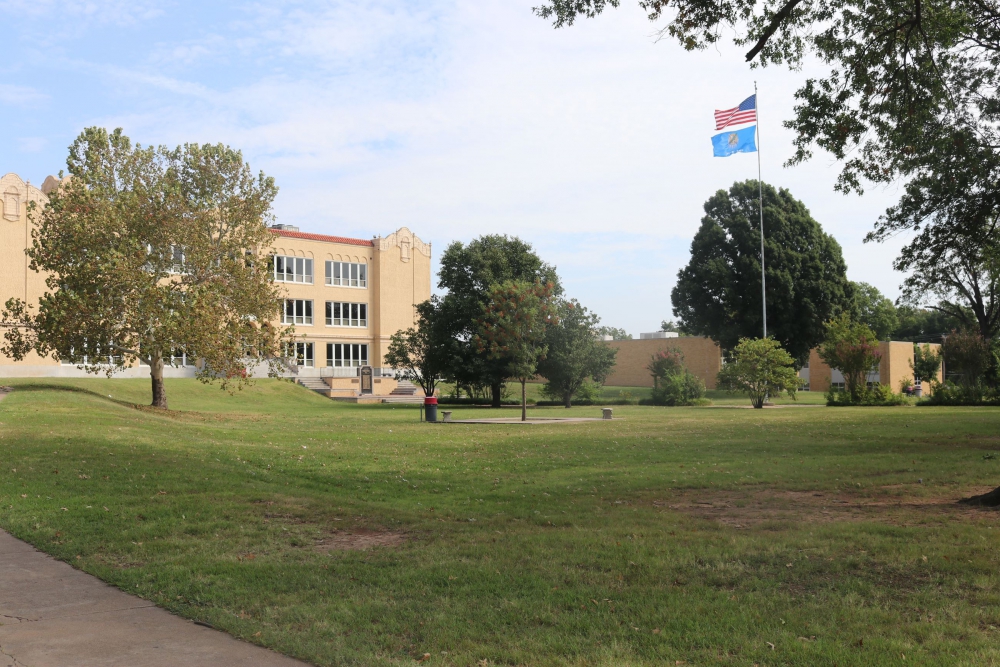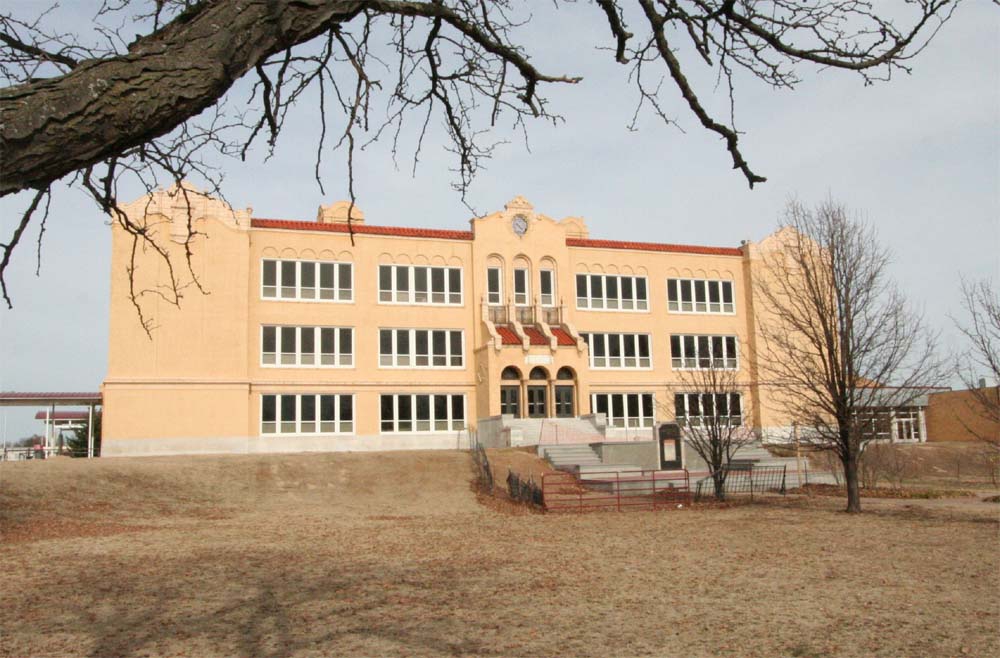Ponca City, Oklahoma High School Veterans Memorial
The memorial is situated on the smaller lower patio, of two patios, and is set into a slope rising from the primary entry walkway up to a larger upper patio in front of the main entrance to the building. The lower patio is reached by a wide set of concrete stairs leading up from the entry walkway to the memorial level. The memorial is centered on the lower patio, and rises from the lower patio upward, and stands some 4 feet above the upper patio level. Additional concrete stairs, on both the left (north) and right (south) sides of the lower patio, lead to the upper patio. A 3 ½ foot protective black iron railing borders the raised upper part of the memorial and extends to the side stairs, and then east along the staircase, along the upper patio. Both patio areas are bricked and bordered by concrete and stone. The facing walls, upon which the memorial tablet and plaques are mounted, are the same color as the building. The main feature of the memorial is a large, vertically-displayed bronze tablet, mounted on a polished black granite wall. At the top of the tablet is a raised American Eagle with wings displayed, above 2 separated iron links in arcs, and suspended from 2 rosette ornaments. The tablet is framed by a shaped concrete decorative molding. The tablet is inscribed: “THIS MEMORIAL IS DEDICATED BY PONCA CITY SENIOR HIGH SCHOOL TO HONOR OUR FORMER STUDENTS WHO SERVED IN THE ARMED FORCES IN WORLD WAR II, AND TO PERPETUATE THE MEMORY OF THOSE WHO GAVE THEIR LIVES FOR OUR COUNTRY.” There follows the etched names of 71 deceased veterans/former students who were killed in World War II (WWII). At the base of the tablet is etched the year that the tablet was dedicated – “1948.” Other elements of the Memorial include 2 bronze memorial plaques mounted on a stone wall to the viewing left (north) and right (south) of the large tablet. The left plaque is inscribed: “THESE FORMER STUDENTS HAVE GIVEN THEIR LIVES IN THE SERVICE OF OUR COUNTRY SINCE WORLD WAR II.” Then listed are the names of 9 veterans and former students who died while serving during the Cold War period (1947-1953), Berlin Airlift period (1948-1949), and Korean War period (1950-1953). At the bottom of the plaque is inscribed the year the plaque was dedicated – “1953.” The right Plaque is inscribed: “FORMER STUDENTS WHO GAVE THEIR LIVES IN THE SERVICE OF OUR COUNTRY 1953-1976.” Then listed are the names of 14 veterans and former students who died while serving during the period between the Korean War period and the end of the Vietnam War period. (Note: Ponca City High School is a public high school in Ponca City, Oklahoma with an enrollment of some 1,637 students in grades 9-12, and a faculty of some 103.) (Note: Ponca City is a city in Kay and Osage Counties, in north-central Oklahoma, some 18 miles south of the Kansas border, with a population of some 24,527 (2016). It is the largest city in Kay County and is situated on the Arkansas River. The city was named after the Ponca Indian Tribe, which had been removed from Nebraska and resettled on allotted lands in Indian Territory (Oklahoma) from 1877-1880. The city’s economic development has been largely dependent on the boom and bust periods of the petroleum industry. It was a refining center for many years and the home of Marland Oil Company, and headquarters for Continental Oil Company (Conoco).) (Note: The memorial honors veterans of World War II, in which some 16.11 million U.S. military personnel served, from 1941-1945. U.S. military forces suffered 405,399 deaths, including 291,557 battle deaths. An additional 670,846 were wounded. Some 4,497 Oklahoman veterans were killed in action, died of wounds, or were killed in combat or while a Prisoner of War. Over 60 million people perished during this global war, which makes it arguably the most cataclysmic event in human history.) (Note: The Cold War periods are those periods in American military history, between declared wars, periods of national emergency, specified periods of hostility against opposing enemy forces involving armed combat, and stated military operations and campaigns. It is a political condition between nations, when there are hostile or belligerent relations, which do not manifest in overt military or violent confrontation, and during which, diplomatic relations are normally maintained. The term is generally thought of by Americans, as the period of on-going hostility between the United States and the Soviet Union, from 1945 (the end of WWII) to 1991 (when the Soviet Union collapsed.) (Note: The Berlin Airlift period was from June, 1948 to September, 1949, when American and Allied forces flew 277,000 aerial missions and delivered some 2.3 million tons of supplies to Berlin, West Germany. Americans flew about 75% of the missions. The airlift was in response to the Soviet and East German blockade of land and water routes into West Berlin, Germany. The massive airlift of food, water, medicine, fuel and other supplies to the over 2 million citizens of the besieged city, lasted for over a year and sustained the citizens until the blockade was lifted. It is considered one of the most remarkable aviation feats of all time, considering that a plane full of supplies had to touch down every three minutes to keep up with the needs of the city.) (Note: The Korean War was a war between South Korea and North Korea. It began on June 25, 1950, when North Korea invaded South Korea. The United Nations (UN) came to the aid of South Korea, and 21 UN-member nations provided forces and support. The United States provided most of the fighting forces. The Soviet Union and China supported North Korea. Fighting ceased on July 27, 1953, when an armistice was signed. To date (2017), no peace treaty has been signed. Due in part to the inconclusive end to hostilities, the lack of public attention by Americans, both during and following the so called, “police action,” and the sequencing of the conflict between WWII and the Vietnam War, the Korean War is sometimes referred to as the “Forgotten War.” The Memorial honors veterans of the Korean War, in which some 1.8 million U.S. military personnel served in the theater, from 1950-1953. U.S. military forces suffered some 36,574 deaths, including some 33,739 battle deaths. An additional 103,284 were wounded. Between 601-625 Oklahoma veterans were killed in action, died of wounds, or were killed in combat or while a Prisoner of War. Some 3,000 Oklahomans were wounded in action.)
Search Google for this memorial
Search Google Maps for this memorial
Organization Responsible for Installation:
City of Ponca City, Oklahoma
Memorial War Era(s):
Vietnam
Korea
WWII
Other
Location:
Ponca City, Kay County, Oklahoma 74601, at 927 North Fifth Street. The memorial is located on the west lawn of Ponca City High School, between the main entrance to the Charles P. Howell building and the primary entry walkway leading to the school from Fifth Street.
Photo Gallery:


Published on December 21, 2017
